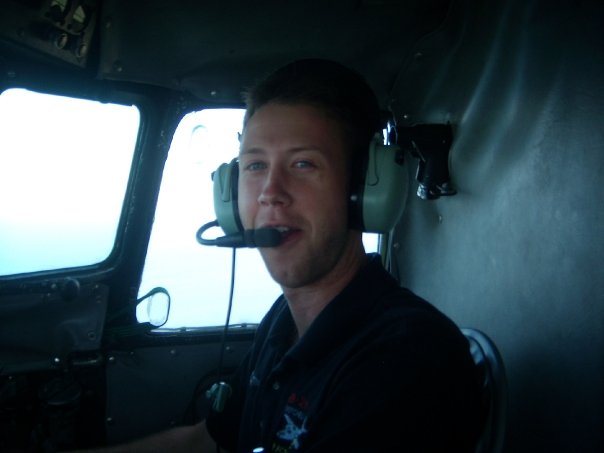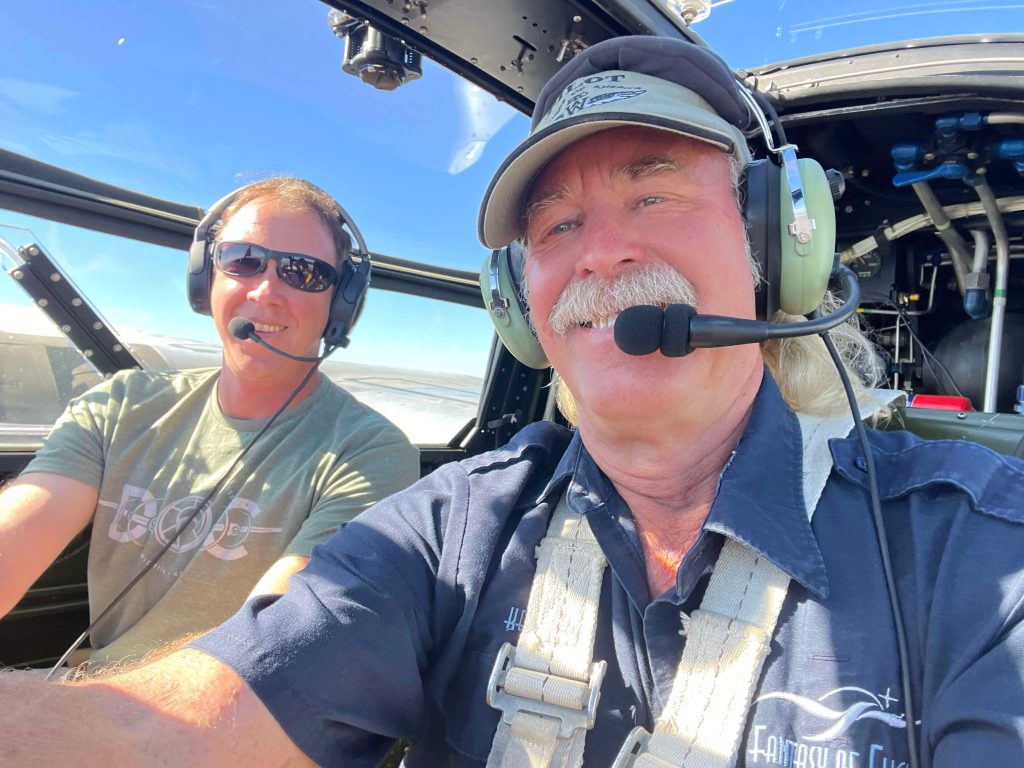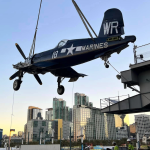With just sixteen airworthy examples, the Douglas A-26 Invader is not the most numerous warbird out there, which means qualified pilots are equally rare. However, among that small cadre, there is one pilot, Stephen Swift, who has four (approximately 38% of the population) of the world’s flying Invaders in his logbook. How does one become so prolific in Douglas twin-engine hot rod? Vintage Aviation News’ Moreno Aguiari sat down with Stephen to find out.

A native of the Lone Star State, Steve is one of those people that was born with that aviation “gene”. It’s as simple as that as Steve explained, “I think aviation found me. I have always loved airplanes. I think living under the flight path of DFW and growing up there didn’t help much, but I just always loved airplanes. Started building models when I was a kid and it just kind of ran from there.” Steve got his first taste of the sky in a Piper Cherokee in Addison, Texas. He’d been flying flight simulators throughout his teen years, but this first flight in a real airplane set the hook for life.

Soon after that flight, Steve dove right into flight training, “So I got my private in 2001 and it was kind of hard to find time to fly because I was in A&P school at the time. Getting my A&P is what really opened doors in aviation for me. As soon as I got my A&P, I went to work for the Collings Foundation as a crew chief and mechanic, and I was on the road with them from 2002 to 2005. During my time off in the winter, I was back home knocking out my ratings one by one. By 2005 I had a commercial, multi, and instrument, and did a little bit of flying with the foundation, but mostly wrenched on airplanes.

After that, I came back to Texas and worked on my undergrad in aviation. Imagine that. Professional pilot. So again, I just continued to fly a little bit here and there. I met up with Jim Terry and flew his B-25 for a couple of years and we did air shows and rides from Florida to Alaska over those couple of years. So, in those couple of years, I got a lot of experience flying all over the country while working on that B-25. In 2010 I went to work for American Eagle Airlines and then joined Spirit in 2014.” Steve related. While Steve’s rise from Embraer 145 First Officer to A320 Captain is an accomplishment to be proud of, we’re here to talk about his career flying real airplanes.

Though his first job in Warbirds was with Collings, it was not Steve’s first exposure to warbirds. He explained, “Around 1994, a buddy of mine and I went over to the Cavanaugh Flight Museum in Dallas. They let us sit in the Corsair thereafter we cleaned it, and that was sort of like feeding a starving puppy because we went back every weekend and eventually became volunteers. After about a year and a half, I heard about a B-17 down in Fort Worth. It was Doc and Chuckie Hospers airplane, and they took me under their wing through high school until the airplane was sold [To the Military Aviation Museum- Author] in 2010.” During his tenure at Cavanaugh, Steve got his first warbird ride in the museum’s PT-19. He said it was “magic” and solidified what he wanted to do with his career.

As PIC, Steve’s first warbird flight was in the left seat of B-25J USAAF #44-30823 Pacific Prowler (N1042B), which is of course the famous Tallmantz cameraship that is known today as God and Country. This article, however, is not about Steve’s overall career in warbirds, but about how he became a connoisseur of the Douglas Invader. Steve began, “My introduction to the A-26 came in 2014 with the Commemorative Air Force’s (CAF) Invader Squadron. It was the old Spirit of Waco (A-26B USAAF #41-39427, N25RP) which had been in Waco, Texas for many years. When the squadron dissolved the aircraft was turned back into headquarters and the new squadron was formed here. The airplane came to Doc and Chuckie Hosper’s place in Fort Worth. At first, I didn’t have a whole lot to do with it because I was busy with other stuff, but the squadron needed a maintenance officer, so they approached me, and I was happy to help.
So, in 2015, I became the maintenance officer for the unit and started working on the airplane through the winter of 2015 & ’16. When we got it flying in ‘16, I started flying in the right seat and by the end of the year I had my type rating.” Steve’s prior experience in warbirds, procedures, systems, etc., helped him tremendously in earning his A-26 type rating. Steve went on to explain the specifics of training in the A-26, “The A-26 was originally designed with only one pilot station, so there was only the left seat. There was a right seat, but there was no instrument panel, just a tunnel to get up front. Now, since World War II, our A-26, Night Mission, has been extensively modified throughout its life, including conversion to two pilots by Grand Central in California in the ‘50s.

So, as always you start a checkout with a ground school, which includes a process that will get you certified and approved by the CAF to fly the right seat in the airplane. Once approved, you hop in the right seat and read the checklist and do all your copilot duties, but not before you observe someone else, that way you get to see the flow of things and how the checklist and procedures work.” Steve noted that a “full set of controls” in the right seat includes everything but brakes. There is a rudder bar for the co-pilot, but a pilot in training cannot taxi the aircraft.
So, what are the flight characteristics of the hot-rod warbird that is the A-26? Steve happily described the experience, “It’s a smooth and well-balanced airplane. It’s very fast. When you point it downhill, the airspeed just goes. It also has good single engine performance with speed.” Since he first earned his type rating, Steve has enjoyed this performance in not just one, but four separate Invaders- A-26B USAAF #41-39427 (N240P) Night Mission, A-26B USAAF #41-39230 (N9682C) Lady Liberty, B-26K USAF #64-17679 (N4988N) Special Kay, and Kermit Weeks’ A-26B USAAF #41-39401 (N39401) Pistol Packin’ Princess.




The privilege of flying four different A-26s can come with perks, and one in particular is the chance to fly with numerous warbird personalities. Stephen explained, “I recently had the privilege to fly with Kermit Weeks and Steve Hinton. I’ve met Steve a few times, but I didn’t know him very well. To get to fly with him was amazing, the man’s reputation is definitely earned. He’s very professional, knowledgeable, friendly, and just a natural. I learned a lot flying with him. He’s always looking to the next thing, always thinking ahead, which is very good when you’re flying airplanes, especially warbirds. He has a very analytical mind while he is flying, and I think that’s probably one of the reasons he’s been so successful along with just having some natural-born talent.

It was very much the same with Kermit. He is a very nice guy and very genuine. Everyone has seen his videos, and I can say that he is the same in real life. He’s just a super nice guy, very knowledgeable and very talented.”
Having accomplished so much in his relatively short warbird career, what is Steve looking forward to in the future? “Well, I don’t know.” He said. “It’s one of those things; it’s just whatever opportunity comes along. For right now though, I’m enjoying my T-6, and of course being involved with Tora, Tora, Tora is an absolute blast. It is one of the best groups in warbirds and I feel very privileged to be among their membership.” When it comes to the A-26, Steve said that Night Mission, has been down for two years and it is hoped that they can get the engine reinstalled over the winter and it will be ready to fly in the spring. As always, however, it takes time and money. That is the biggest challenge in flying warbirds.
In the end, Steve told VAN, “I’ve just been very lucky and privileged to be able to do the things I’ve done and to fly with the people I’ve flown with. I’ve always said, the flying is great, but it’s the people that really make this kind of flying fun. I really believe that aviation has just some of the best people in it, and warbirds are the best of aviation. I wouldn’t be here without a lot of help and a lot of support. I think it’s important that we pass that down as time goes on.”

































